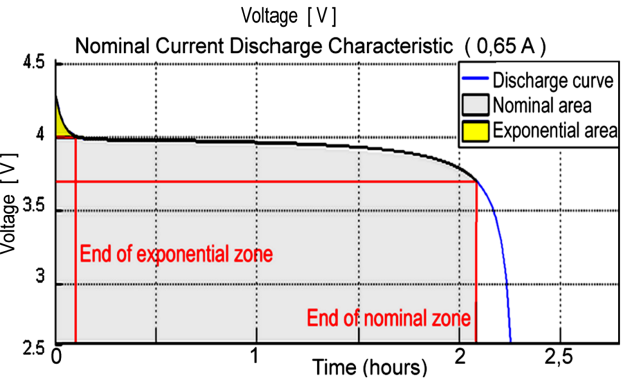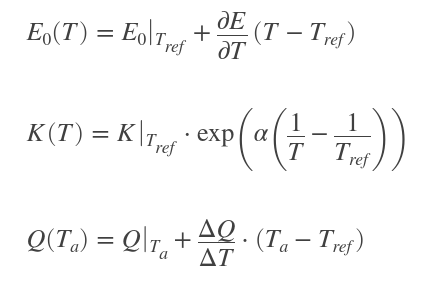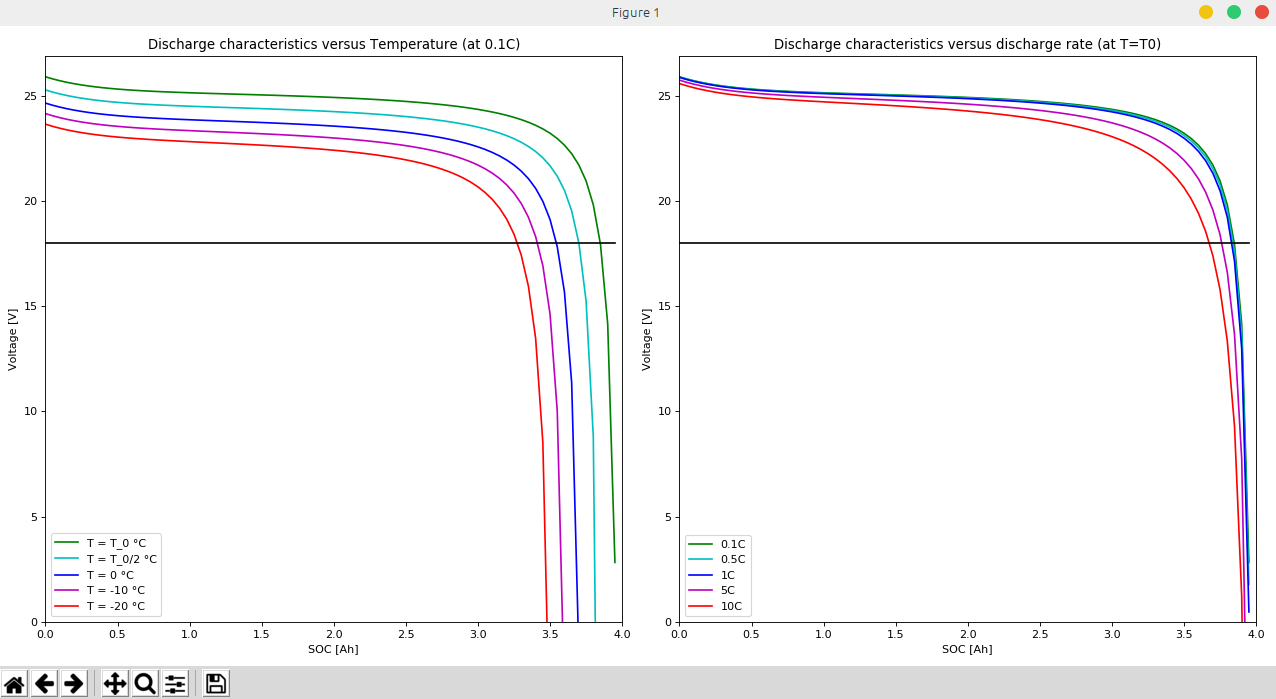This repository contains small modifications to use the original plugin with ROS2 Humble.
This repository contains a generic battery plugin for Gazebo to be used in ROS robot simulations. It implements two operation modes, a simple linear charge/discharge model and a parametric nonlinear dynamic discharge model. For the parameter tuning of the latter we provide a visualization tool of the discharge curves under various temperatures and current loads.
Discharge characteristics of chemical batteries is represented by the graph below. The first section - exponential area - shows the exponential voltage drop starting from a fully charged state. ( The width of this section depends on the battery type. ) The second section - nominal area - represents the charge that can be extracted from the battery until the voltage drops below the battery nominal voltage. The last section shows the total discharge of the battery, when the voltage drops rapidly.
In this mode of operation the charge drops in a linear fashion respect to the current drawn from the virtual battery without taking temperature into consideration.
Where
-
V is the current voltage [V],
-
V0 is the voltage of the battery when fully charged [V],
-
α is the linear discharge coefficient,
-
it is the accumulated discharge [Ah],
-
Q is the design capacity of the battery [Ah],
-
R is the internal resistance of the battery [Ohm],
-
and i is the current drawn. ( after processed by a low-pass filter ) [A]
Nonlinear dynamic discharge model is formulated as
where
- A is the exponential voltage [V],
- B is the exponential capacity [1/Ah],
- T is the temperature of the battery [C],
- Ta is the ambient temperature [C],
with the impact of temperature on the model parameters
where
-
K is the polarization constant [V/Ah]
-
Tref is the reference or design temperature [C],
-
α is the Arrhenius rate constant for the polarization resistance.
For convenience we have provided a xacro to include the nonlinear model that reads the parameters from a yaml file. If you would like to use the linear model, include it as you would with any other gazebo plugin.
<xacro:include filename="$(find gazebo_ros_battery)/xacro/battery.xacro"/>
<xacro:battery sensor_name="battery" frame_id="battery_link"
params_yaml="$(find gazebo_ros_battery)/params/G24B4.yaml"/>When loaded it will publish noetic Battery State messages on every state update. To attach consumers to the virtual battery, just provide the number of channels ( any dynamic and static consumers ) and the plugin is going to create numbered std_msgs::Float32 topic subscribers under the prefix of consumer_topic.
When the virtual battery is fully discharged, or the simulated electronic protection cuts off the voltage, you can call either the Reset service or the setCharge service to restore its charge state.
Ambient temperature can be set through the setTemperature service, internal temperature of the battery is then calculated to change in accordance with the temperature_response_tau parameter.
Mode of operation is chosen through the use_nonlinear_model parameter. ( Defaults to True )
current_filter_tau- is the coefficient for the low pass filter on the drawn currenttemperature_response_tau- is the coefficient for the internal battery temperature filterupdate_rate- is the fixed frequency of the model update function [Hz]rosDebugLevel- sets the plugin log level, debug by defaultnum_of_consumers- number of load subscribers to instantiateconsumer_topic- topic prefix of the numbered load subscribers (/battery/consumer/0)frame_id- the transformation frame associated with the battery in the URDFbattery_topic- battery state message topic namepublish_voltage- whether to publish battery voltage asstd_msgs::Float32alongside the status messages ( gazebo_ros_motors compatibility )battery_voltage_topic- name of the battery voltage topic if enabled
linear_discharge_coeff- or **α **as described in the model section - is a weight that sets how much the actual charge is considered in the calculation of the discharge curve steepness.
polarization_constant- or K - is the polarization constant [V/Ah]exponential_voltage- or A - [V] is the voltage at the end of the exponential areaexponential_capacity- or B - [1/Ah] is the capacity at the end of the exponential areacharacteristic_time- characteristic time [s] of i*design_temperature- or Tref- Design temperature where polarization constant is unchangedarrhenius_rate_polarization- or α - Arrhenius rate of polarization constant [K]capacity_temp_coeff- Temperature dependence of capacity [Ah/K]reversible_voltage_temp- Linear temperature dependent voltage shift [V/K]
Usually some parameters and a discharge curve is provided by battery manufacturers. In order to properly simulate the discharge of an unknown battery it is best to plot the voltage drop against a fixed current at a given temperature. Either way there has to be a plot that can be compared against the expected runoff of the model.
- Acquire the discharge curve of the given battery.
- Create a parameter file ( duplicate the one provided ).
- Use the
battery_config.pytool in theparamsfolder to visualize the models curve. - Adjust the parameters in the
yamlfile until the fit is acceptable. - Load the same parameter file with the
xacroto run your battery simulation.
~/gazebo_ros_battery/params$ ./battery_config.py G24B4.yaml
Authors: Marton Juhasz - nilseuropa, Gergely Gyebroszki - gyebro
Sources: https://www.mathworks.com/help/physmod/sps/powersys/ref/battery.html




